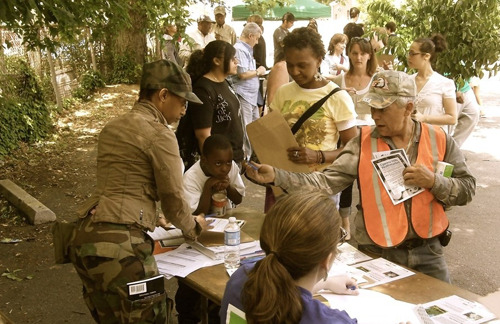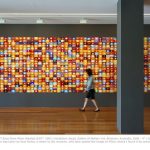Con Edison Immigrant Artist Program Newsletter, Issue No. 26
Featured Organization: The Pratt Center for Community Development
The Pratt Center for Community Development works with community organizations in all five boroughs to shape the local built environment and develop strategies for preserving and creating affordable housing, decent schools, desirable retail, accessible open space, and authentic neighborhood character. In the 1960s, the Pratt Center and Senator Robert Kennedy’s staff jointly developed a model for capital investment and urban renewal services in Bedford-Stuyvesant; that model would later influence Kennedy’s creation of the Community Development Corporation and a new federal program to fund CDCs.
Since then, the Pratt Center’s projects have included a planning study emphasizing housing stabilization and community revitalization for East Flatbush; a design and funding strategy for rowhouses in Longwood; and design and restoration work for the historic homes of Weeksville Heritage Center. Jack Newfield wrote in The Village Voice that the Pratt Center was “the conscience of the city in all public policy questions involving zoning, housing, and land use.”
In recent years, the Pratt Center has developed an additional focus on promoting environmental justice. Its Sustainable Neighborhoods Program makes buildings in New York City more energy efficient with projects like Sustainable Houses of Worship andSolar Power in NYC. Having secured a Rockefeller Foundation NYC Cultural Innovation Fund award, the center will team up with community development groups in New York City to develop innovative cultural, arts, media and organizing strategies to engage neighborhoods in making healthy consumer choices and taking environmental action. As part of its ongoing effort to support artists and arts organizations to develop activities – such as performances, installations and workshops – that promote a civic dialogue about community sustainability, the Pratt Center will be participating in the event “Seeding the City: Learn How to Live Green in the City” co-presented by IAP and The Laundromat Project at the end of this month. IAP Program Officer Karen Demavivas and Intern Emily Chen interviewed Rasu Jilani, the Pratt Center’s Art, Culture and Sustainability Projects Consulting Manager, about its activities beyond “Seeding the City.”
IAP: When and how was the Art, Culture and Sustainability Initiative started?
RJ: The Art, Culture and Sustainability Initiative began January 2011 with the premise that the arts can be a powerful catalyst for social change and are part of Pratt Center’s greater vision for equitable, sustainable, and culturally vital communities. The goal of our project is to fully integrate art and sustainable development.
This initiative has allowed Pratt Center to create a special “Arts Implementation Fund” to support the execution of visual and performance art works with sustainability themes created by artists and art groups in Bedford-Stuyvesant, Cypress Hills and East New York.
In April 2011, I was brought in as a consultant to manage the community engagement projects sponsored by the “Arts Implementation Fund” currently being piloted in partnership with the Bedford Stuyvesant Restoration Corporation (BSRC), the Cypress Hills Local Development Corporation (CHLDC) and ARTs East New York.
IAP: What were the outcomes of the initiative’s two completed projects: After School Environmental Literacy & the Arts with Bedford Stuyvesant Restoration Corporation (BSRC) and Energy Block Party and Tree Give-away with Cypress Hills Local Development Corporation (CHLDC) and ARTs East New York?
RJ: Bedford Stuyvesant Restoration Corporation’s (BSRC) The Youth Arts Academy was a twelve week multidisciplinary program for thirty 2nd grade students from C.S. 21 & P.S. 93 that met twice a week. The program is designed as an introduction to environmental literacy with a focus on food, agriculture, ecology, economy and energy efficiency. The arts served as a tool to encourage children to “go green” recognizing that at an early age they can impact their own future. The program explored the environment and perspectives, reflecting attitudes and awareness in their own community beginning in their homes.
BSRC used the arts as a bridge to environmental consciousness by engaging students in dance, creative writing, and visual workshops. Performance opportunities connected with the “DanceAfrica” project and school showcases helped add to their learning experience. By developing the students’ awareness in different topics of sustainability and environmental responsibility through this program, BSRC hopes they will become leaders in their community and encourage others to follow their example.
Cypress Hills Energy Block Party (CHLDC) launched a 250 tree give away in partnership with MillionTreesNYC and the Pratt Center on June 4th, 2011. The event welcomed hundreds of residents of both Cypress Hills and neighboring communities. They were entertained by live music by Ola Fresca and a drummers circle and informed about sustainable living by a variety of green advocacy organizations. The youth participated in the making of a live community mural that represented a neighborhood pledge to action toward sustainable living in Cypress Hills, thanks to ARTs East New York.
ARTs East New York kicked off their first week of Summer Saturdaze on Saturday, July 9th 2011. The event theme was “SANKOFA” – African music, dance, poetry and art – and there was a community discussion on recycling and energy efficiency. Summer Saturdaze will continue every Saturday until August 27th, 2011 at the East New York Farmers Market located at 613 New Lots Ave, Brooklyn, NY. For more information about Summer Saturdaze, visit http://www.artseastny.com orhttp://www.eastnewyorkfarms.org.
IAP: The Pratt Center has partnerships and a community development record in Jackson Heights, East New York, South Bronx, the Lower East Side, Downtown Brooklyn and Bedford-Stuyvesant. What are some factors it considers for allocating resources and implementing programs into these and other prospective neighborhoods?
RJ: Pratt Center works with community-based organizations in low and moderate income communities throughout NYC, providing technical assistance in planning, policy, architecture and organizing to advance a social agenda informed by and defined in large part by those communities. We do this work in partnership so it’s not about allocating resources, but rather developing programs and campaigns collaboratively, where oftentimes the community-based organization is the client for which we work.
Factors that we consider include: whether the community and project fit our mission; fit of the task at hand with the skill-set and expertise that we have; uniqueness of the value that we can add; and whether we are being invited to partner with certain community groups to assist in their planning and development.
IAP: Art may be viewed as the transformation of content and material. In the context of urban planning and community development, how does creativity come into play in transformative strategies to revitalize the city?
RJ: Community development, urban planning, and revitalization of a city is an art in itself. There are many factors to consider when initiating these processes and it takes creativity to craft the right team, efficiently gather data, identify the needs of a community and develop the most effective strategy to resolve issues identified.
However, art is expressive and utilizing artists in urban planning can assist in creatively identifying the interests and needs of the community at large. Art can also be used as a tool for engaging communities to gather important data. For example, we use design charettes, community workshops, festivals, farmers markets and murals as creative methods to gather information and survey the community we are servicing. Using the arts in the planning process and taking a creative approach has also helped us to identify neighborhoods where a creative energy has organically taken hold and then nurture that development with modest interventions and incentives. Pratt Center will continue to engage its projects with this creative planning model as an essential element of community development.
IAP: The immigrant population in New York City influences the diversification of all sectors, including culture and the economy. In a New York Times report on food business development,
[Pratt Center Director] Mr. Friedman said the mix of cultures and steady flow of immigrants in the city created “new ideas for food,” some of which could become popular enough to be exported regionally or nationally.
How does the Pratt Center engage immigrants in their programs such as the Arts, Culture and Sustainability Initiative, given the significant role these populations play in shaping the profile of New York City?
RJ: Immigrants and immigrant communities are at the heart of what makes this city great but they also experience some of the most acute consequences of the ways in which we have not yet succeeded in making this a just and equitable city. As such, we are intentional in our efforts to partner with organizations that are housed in and serve immigrant communities, and that do so in ways that are appropriate to the linguistic and cultural contexts within those communities. Specifically, through our work with Retrofit Block by Block NYC, Queens for Affordable Housing and our involvement in the New York Immigration Coalition’s Housing Collaborative, we have provided analysis and organizing assistance in the immigrant struggles to increase the availability of affordable housing overall, to ensure equal access for immigrants to the affordable housing that exists and to ensure that the housing stock where immigrants currently live is decent and safe.
In our transportation equity work we also work with partners serving immigrant communities to advocate and organize around transportation policy and planning that will best serve them. Our work on economic development policy and supporting NYC’s manufacturing sector, where 63% of the workforce is immigrant, is centered around fulfilling the promise of opportunity that brought many immigrants here.
Rather than thinking about the ways that we include immigrants in our work, we’d be hard-pressed to identify an area of work that doesn’t touch upon strengthening immigrant communities, in partnership with the entities that directly serve them.
The general diversity of arts and culture in NYC is directly related to the city’s rich immigrant population. The 1st and 2nd generation immigrants bring with them their traditions, which are exhibited in their artistic and cultural expression. At Pratt Center it is our endeavor to capture this diversity in our Arts and Cultural Initiative in order to give an accurate representation of the communities at large.
IAP: How can artists and activists get involved in the Arts, Culture and Sustainability Initiative?
RJ: The projects related to the Arts, Culture and Sustainability Initiative are designed to rely on the creative talents of artists to promote sustainability and environmental awareness through artistic measures. There are several ways artists and activists can participate in our up and coming projects:
- Staying abreast with our upcoming events by visiting http://prattcenter.net
- We are always looking for artists and volunteers for our projects and community engagements. Interested participants should contact me directly, [email protected]
- Pratt Center, The Pratt Initiative for Arts, Community and Social Change (IACSC) and Bedford Stuyvesant will be partnering on the “Amplify Action: Sustainability Through The Arts” group exhibit in 2012. The artist call was released Friday, July 15th, so we are accepting submissions for the exhibit from interested artists.




